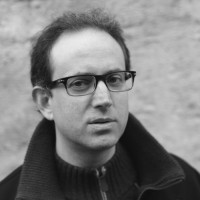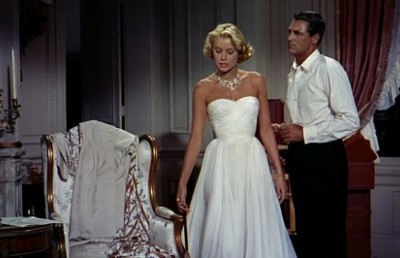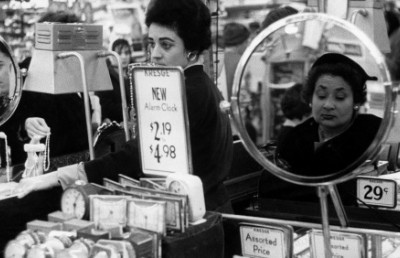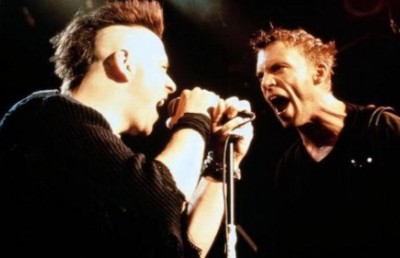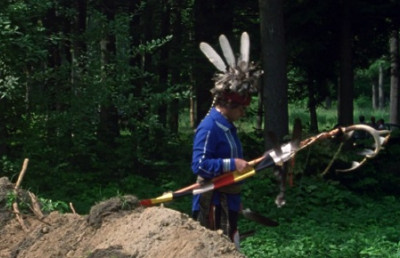Reviewing Vancouver’s Experimental Film Scene in Richard Martin’s Documentary Backbone
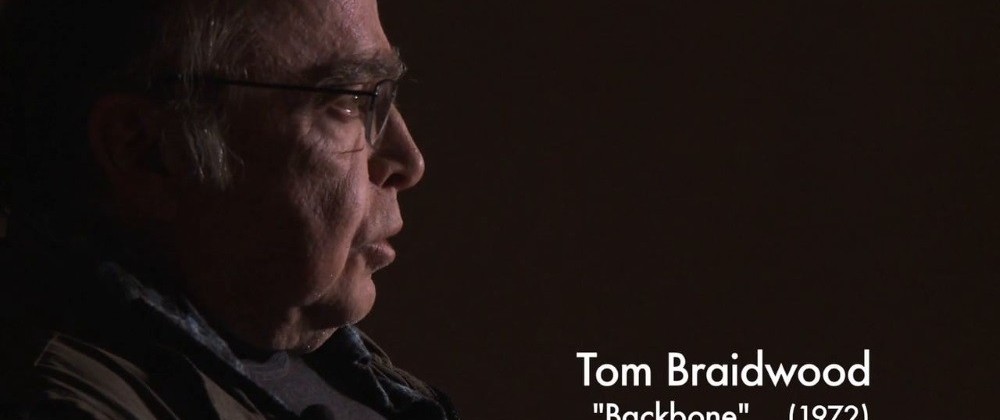
Trailer for Richard Martin’s documentary Backbone: Vancouver Experimental Film 1967-81
I remember Chris Gallagher’s Seeing in the Rain in my intro to film class in my second year at U.B.C. where Gallagher taught. It was, perhaps, my earliest exposure to experimental film as a genre, and I didn’t like it at the time. The endless views out onto the rain soaked streets of Vancouver from the vantage point of a lumbering city bus, cutting between differing views on the beat of each swipe of the windshield wipers. It was the last thing I wanted to see after having endured those same views day in and day out for years on end as I made my way around the city, as though recreating the sense of falling asleep and being jerked awake to realize you’re not where you were a moment ago, over and over and over again. Pure tedium, I thought. It takes forever to get to places in Vancouver on those busses, and the rain is demoralizing. Of course the film breaks this up through its central formal conceit. In retrospect, with nearly two decades of remove from the drudgery of Vancouver’s public transportation and a new appreciation for experimental filmmaking thanks to my graduate studies in film here in Montreal, I can appreciate Gallagher’s technical approach and how it so elegantly captured a slice of Vancouver experience true to life in the city in a way that standard narrative approaches to filmmaking simply could not. Living in Vancouver it hit too close to home. Being away from home, the film now brings me back. And it is this kind of rediscovery of my city at a distance through the films that have been made there that drives much of my current work as a researcher and filmmaker. So I was ecstatic when I heard that Richard Martin had made a documentary on the Vancouver experimental film scene of the 60s and 70s. What I wanted most from the film was for it to delve deep into the relationship between filmmaking and engagement with place. How did it fare? Read on.
Richard Martin’s documentary Backbone: Vancouver Experimental Cinema 1967-81 (2012) embodies some of the central problems of adopting a celebratory tone on the occasion of Canada 150. Its goal is to call attention to a body of work all too often ignored even within Canadian film studies, to investigate its regional specificity, and argue for its uniqueness both in Canada and on the global avant-garde scene. In so doing the film demonstrates the futility of questions that dominate celebratory evocations of our nation’s 150th, like the existence of a coherent Canadian identity or recurring sensibility that can be traced through the artistic output of those that live within our artificial borders. The film also makes an attempt at celebrating a Canadian scene by focusing on regional specificity, diverse perspectives, and alternative histories, all necessary when questioning the cost of fervent nationalism and the goals of a milestone like Canada 150. Backbone succeeds in exposing the work of several key filmmakers on the Vancouver scene in the 1960 and 70s, and offers a useful history of the institutions that emerged around it. But the film lacks depth in its attempt to reveal the ways in which these films were a specifically Vancouver phenomenon, and is light on the stories behind the films that these people were making. In the end it serves more as a useful introduction to experimental filmmaking in general with Vancouver examples, while falling into the trap of defining the Vancouver scene according to what it was not: Toronto, thereby replicating the tendency to define Canada as what it is not: the U.S.A.
As a born-and-raised Vancouverite I can attest that Vancouver is a much more interesting place than simply the anti-Toronto. But wherein lies this interest? This is a question I was hoping Backbone would try harder to answer, even if the task is ultimately impossible. Backbone’s defining claim about Vancouver as the soil that these filmmakers tilled is that the city featured a special balance between the city’s isolation from outside influence and its openness to experimentation and alternative ways of doing things. Martin opens the film through a reference to the 1966 Trips festival held at the Pacific Nation Exhibition, featuring a host of musical acts from San Francisco, held up as evidence of Vancouver’s early openness to the age of psychedelic experimentation, the backdrop for the film’s exploration of the films that followed. Yet this reference also points to the film wanting to have its cake and eat it too. It was, indeed, a prescient move to host the Trip’s festival at a relatively early stage in the psychedelic explosion, indicating that Vancouver was not slow to catch onto trends blooming down the coast. And yet, Martin makes much of Vancouver’s artistic isolation as a major factor in the kind of work he showcases in the film. If the Trips festival suggests early awareness of the hippy scene as influence on Vancouver artists, where does the suggested isolation from the outside world figure in?
The tension between prescience and ignorance in Vancouver is exemplified by the Grateful Dead’s recent official release of their performance at the Trips festival as a bonus disc to the 50th anniversary edition of their first studio album (as well as a vinyl edition for Record Store Day 2017). At the opening of the set, an introduction of the band is met with almost absolute silence from the crowd. Bassist Phil Lesh takes to the microphone with a note of sarcasm before they launch into their first number: “Our fame precedes us!” Although only a year into their career as a band, they were already well known in San Francisco. But the Vancouver gig was their first paid performance outside of California, and with only one album under their belt one wonders how well they should have been known elsewhere, even if just a few hours up the coast. Maybe Vancouverites could hardly be faulted for not being aware of the Grateful Dead in 1966. Or maybe it was a place where people really didn’t know what was going on elsewhere, but were happy to hear about it if it crossed their paths. The Trips festival might have been an example of simultaneous openness to and ignorance of the world outside Vancouver’s borders. But if Vancouver didn’t know the Grateful Dead in 1966, how aware should they have been of filmmakers well established since the 40s and 50s like Stan Brakhage, Maya Deren, Bruce Connor, Jonas Mekas, to say nothing of the European avant-garde of decades past? Backbone, like so many filmmakers bent on maintaining the façade of artistic originality, shies away from discussing such influences.
David Rimmer cites lack of film school as major influence on his artistic direction.
Throughout Backbone filmmakers and talking head experts repeatedly refer to the fact that Vancouver filmmakers of the 1960s and 70s were unburdened by influence or education, fumbling their way into discovering the medium of film in all its material glory. The results are clear to see through the excerpts presented in the film, culled largely from gorgeous new transfers made for a companion set of 10 key films of the era available for exhibition rental and institutional purchase through Moving Images Distribution.
The variety of work on display here is impressive. Everything from the politicization of the collage aesthetic in Gary Lee-Nova’s Steel Mushrooms, alternative processing in Al Razutis’ Lumière’s Train (arriving at the station), looping and experimentation with audiovisual synchronization in Tom Braidwood’s Backbone (after which Martin named his documentary), the extraordinary power of sound to animate the still image in Kirk Tougas’ Far from Quebec, plays with time, rhythm and continuity through cutting in Chris Gallagher’s Seeing in the Rain and optical dissolves in David Rimmer’s Canadian Pacific, and feminist interrogation of domestic gender roles in Patricia Gruben’s psychodramatic The Central Character. Anyone looking to do a survey of experimental film sub-genres and techniques could get pretty far down the road with this set of films, and it is the premises and techniques behind them that the filmmakers are most interested in discussing during their interview segments – or at least that’s what Richard Martin’s editing would have us believe. But how much of this stuff did they really teach themselves in the absence of exposure to all of these techniques and styles in the work of the American and European avant-gardes of the previous decades? And what does this really have to do with Vancouver’s specificity as a place?
Emphasis on process and technique in the film’s interviews.
Martin knows that the film’s emphasis on Vancouver’s cultural and geographic isolation is not a satisfying basis on which to argue for the specialness of these films and the Vancouver scene. So he spends the film’s second section querying the nature of the Vancouver landscape itself and its effects on the people that lived there. Alex MacKenzie, a noted expanded cinema practitioner and curator from a more recent generation, wonders out loud what it is about the west coast that might have inspired such a strategy, or “is it the west coast?” It is clear that Vancouver filmmakers were fascinated by the geographic particularities of their city on the edge of the sea and framed by formidable mountains. Sturla Gunnarsson describes Vancouver as a “total universe of its own” existing in the gloom of pervading mists surrounded by mountains that kept the rest of the world out, mountains that Alex MacKenzie says you can get lost in, die in, unlike any of the “nature” immediately accessible in Toronto or Montreal. Gunnarsson acknowledges possible influence by California, but suggests that by the time the influence arrived in Vancouver it had become much more “brooding.”
Indeed, some of these qualities are well on display in a film like David Rimmer’s Canadian Pacific, a perfect Vancouver view out of his downtown studio window, over the rail yard, out across the water and up against the mountains. Rimmer’s strategy is to dissolve between different takes of this view that span the seasons, Vancouver’s famous rain and fog drifting across the frame then suddenly giving way to spectacular sunlight on snowy peaks before disappearing again. Meanwhile the trains keep rolling, always in silence, until darkness falls and we see Rimmer’s camera reflected in the window-turned-mirror. Alex MacKenzie comments that Rimmer’s strategy of shifting the perspective on that view through the dissolves to different environmental conditions “elevates that landscape” to something different, achievable only by way of Rimmer’s aesthetic strategies. Rimmer says he was motivated by the layers of activity providing a stable basis through which to explore constant change. But approaches like this were hardly new by the mid-70s, and while Rimmer’s claim to have arrived at his strategies through his own experimentation is laudable in its own right, it’s really the relationship between setting and treatment that is most interesting in the film. Martin could have pushed much further with an exploration of the Vancouver-specific context of this setting as impetus for Rimmer’s aesthetic engagement. Subtle changes amidst apparent constancy is a defining feature of the Vancouver experience, where 15 degrees Celsius with light rain could just as easily describe a day in mid winter as mid summer, and the constant tease of the spectacular views that peak out only once in a while through the haze of the cloud cover. This creates and entirely different psychology to the cycles of the year compared with most other Canadian cities that experience wild extremes between winter and summer. But Backbone stops short of such probing.
At another point, Ron Burnett, president of Emily Carr University of Art and Design, muses that “there has to be some component of the intensity of the experimentation, like in Al Razutis, where the atmospheric is continuously imbibed with a sense of place,” but he doesn’t go on to explain exactly how that works. Alex MacKenzie gets closer to the mark by offering the observation that Vancouver features “proximity to capital and nature,” the defining dialectic behind much of the urban studies literature on the city. But that’s about as far as the film gets before it moves back into more general discussions of experimental cinema at large. Other interview subjects comment on the experimental film scene arriving so vigorously in Vancouver as a reaction against the city’s conservative provincialism, but this segment quickly shifts to Vancouver’s complicity with the broader hippy scene in which revolts against the establishment were taking place all over the map. Here Martin shows us excellent Vancouver-specific material from the era, most notably from the CBC’s documentary The Be-In about the process of organizing the city’s first such event in Stanley Park in 1967. But such material simply emphasizes Vancouver’s participation in a larger community without evidence of the distinctly Vancouverite spin present in the original film itself. And when Martin goes on to evoke the later punk movement as another milieu in which avant-garde film experimentation felt at home, we’re given even less about Vancouver’s own rich scene and its local tints, the kinds that inspired Dennis Hopper to adapt his script for Out of the Blue when he arrived in town and discovered what was going on here in the late 1970s.
There are twin problems in play here: just because films are made in a particular place doesn’t mean they necessarily reflect that place; and it’s almost tradition for filmmakers to deflect questions of influence and technique and default to the old “we were just doing what was best for the story” line. I know very well the frustration of trying to get Vancouver filmmakers to express how their experience of the city has fueled their work. My interviews with Larry Kent and Jack Darcus in previous issues of Offscreen didn’t yield much on that particular ground, other than to reveal details of their position within the scene and its historical development. On the other hand, experimental filmmakers love talking about their techniques, since those are generally foregrounded over narrative within the genre. At one point Chris Gallagher mentions that he thinks the idea of filmmakers as storytellers is “quite lame,” as was always more interested in the experience of the medium’s materiality. But there are stories behind the films, stories about life in Vancouver that led to the creation of these particular films, that could have been fleshed out. Backbone succeeds in getting the filmmakers to talk about process, but doesn’t allow enough time for stories within and behind these processes to come through.
There are at least two doors that Martin’s documentary opens onto the issue of regional-specificity but hesitates to pass through. The film does a good job taking us through the development of the Vancouver scene and its local institutions, from screenings on late night CBUT TV to Intermedia and on to the Video Inn and Cineworks collectives. But with the tip of the hat to CBUT, and filmmaker/programmer/host Stan Fox, perhaps Martin would have done better to dial back the clock a bit and acknowledge the alternative storytelling that was going on at the station since it’s beginnings in 1953, charged with exploring the uniqueness of the west coast experience, often with avant-garde characteristics. The 1961 production of City Song is a great example of this, about which I wrote in U.B.C.’s journal Cinephile a couple of years ago. Tim Newman and Colin Browne have also written about the CBUT’s region-specific contributions elsewhere on Offscreen. These were filmmakers who were putting technical experimentation to the purpose of examining the environments in which they lived for a local audience.
The CBUT film unit, and the Pacific division of the NFB founded a bit later, were very interested in how things were happening differently in Vancouver than elsewhere. In the 1960s the city was at war with “blight,” the first step towards a long-term development strategy that yielded novel approaches to city planning that are now studied the world over as “Vancouverism.” In 1974 the city passed a bylaw curtailing signage and other obstructions to the city’s scenic settings, part of the strategy to eventually brand the city as “Spectacular by Nature.” These sparked tensions among different factions in the city. While Vancouver was engaged in a struggle against the kinds of things that were happening in most major cities in North America, its solutions were unique. For example, they successfully resisted a proposed highway to cut through downtown when similar highways were ripping cities apart across North America. Then there are the oddities of legality surrounding occupation of intertidal zones, governed Federally rather than Provincially or Municipally, a situation explored poetically in the CBUT’s 1961 Summer Afternoon about two young boys stealing away from their Chinatown homes to hang out on squatter’s boats in False Creek, and more explicitly in the NFB’s 1972 gem Mudflats Living, about squatters struggle to maintain their residences on the Dollarton flats in North Vancouver. Was there a way in which any of the many experimental films showcased in Backbone that deal with Vancouver’s proximity to water were informed by these kinds of resistance to general urban trends and legal peculiarities? Perhaps acknowledging something of a tradition in the films of the CBUT and NFB would help ward off some of the hyperbole surrounding the apparent ignorance of the experimental filmmakers featured in Backbone and help build a stronger sense of place as context for their work.
Another door that the film opens but doesn’t go through lies in its use of material from the archives of the World Soundscape Project to help bring life to the early 70s period in which the film spends a good deal of time. The sounds serve as little more than backdrop, at one point even sonorizing Rimmer’s silent Canadian Pacific with sounds of the very rail yard that he filmed around the same time. But there is greater significance to these sounds than what is on display in Martin’s film. The “Vancouver Landscape” section of Backbone announces itself with the WSP’s recording of the Hydro building horn blasting “Oh Canada,” followed by their recording of the bells of Holy Rosary Cathedral. These are distinctive Vancouver sounds to be sure, but what do they say about the city? The WSP was heavily invested in examining the significance of such sounds in the context of Vancouver’s modernizing urban environment, developing (albeit Eurocentrically biased) approaches to identifying relationships between sound and culture within a specific geographic region. And their early work recording and assessing Vancouver’s sonic environment led to the artistic offshoot that has come to be known as soundscape composition, a mode of using location-based sound recordings as the basis for composing works that are about the place in which they were recorded. Although it’s not fair to expect all artists to make work explicitly about their places, the Vancouver filmmakers featured in Backbone are clearly more aligned with placed-based filmmaking than Martin’s film lets on.
Kirk Tougas’ Far From Quebec stands as a case in point. The film closes with a lengthy set of repetitions of a single foghorn blast, getting louder and louder each time. The WSP has made a big deal out of the distinctly local qualities of Vancouver foghorns and the problems of their changing design over the years. Tougas’ film has geographical specificity built into its title, but we get nothing about its purpose or the concepts driving it other than as an example of collage techniques in experimental filmmaking. The fog is so evocative of Vancouver’s isolation, listening out into the distance for signs of life. The spirit of the WSP is one that could have animated the Backbone documentary far more substantially to flesh out details like the significance of the foghorn in the context of Vancouver’s changing soundscape of the day and relationship to the east coast.
Perhaps the most useful idea to emerge from the question of regional specificity is that, while the east coast became increasingly interested in developing a sense of Canadian artistic identity, particularly motivated by the CBC and the NFB, Vancouver had no such concerns. While there’s little of interest in the negative definition of Vancouver as “not Toronto,” it is quite interesting indeed to consider Vancouver’s lack of nationalising impulse. This was a time when 70 percent of the population were considered British nationals, yet Vancouver was slow to get on the Canadian national scene. Certainly true, having been born there and lived for a quarter century before moving to Montreal, I can say that I never really felt particularly “Canadian” in any sense, and my trips down the coast to California to catch the Grateful Dead in their waning years of the early 90s I felt much more environmentally and culturally at home than what I found in Montreal upon my cross-country move in 1999. This fuels the claim that Vancouver was isolated and doing its own thing, at least as compared to the rest of Canada. But if this is the most poignant evidence of Vancouver’s regional specificity that can be made, the film has done no better than the general trope of defining Canadian identity at large by what it is not: the U.S.
The film’s final 10 minutes unravel as the discussion shifts away from Vancouver-specificity altogether and towards shifts in experimental filmmaking in general in the age of digital technologies. There are general claims that Vancouver’s own experimental scene dissolved with Vancouver’s arrival on the world stage after Expo ’86 and the city’s establishment as Hollywood North. But this isn’t a satisfying explanation for many changes in the scene. Film historians like David Spaner and Mike Gasher have both demonstrated how the presence of industrial filmmaking infrastructure in the city actually provided opportunities for independent filmmakers to access resources they couldn’t otherwise, which helped launch the Pacific New Wave. I see no reason why experimental filmmakers shouldn’t also have benefited in similar ways. Instead of getting more specific about the benefits of Vancouver’s expanding film scene for independent filmmakers and media artists, the film casts a broader net and talks about the arrival of digital technologies and new trends in audiovisual experimentation that have moved away from the celluloid based experiments of the 60s and 70s. Here the older filmmakers come across largely as sticks in Vancouver’s ever-present mud, with David Rimmer casting the final blow in relating a story about his disdain at being asked what software he was using to create his projections at a recent club gig.
Here the film ends by putting particular emphasis on how there is a lack of education in the history of experimental filmmaking amongst the new generation of media artists re-discovering many of the same techniques in the digital realm. This plays as highly ironic given the film’s early emphasis on how this was the exact position of the Vancouver filmmakers it celebrates, their ignorance of global context and history allowing them the freedom to make the work that they made. I side with the filmmakers and talking head experts about the value of education. But here the film could have doubled down on its claim that there is something different and valuable about this early Vancouver work that has been ignored in the experimental film canon. Ron Barnett’s claim that there are only three or four schools in Canada teaching experimental film classes doesn’t ring true. What is certainly true, however, is that Canadian works get washed over in American curriculum, and that Vancouver works get the same treatment in Canadian curriculum. To properly argue that the Vancouver work deserves a place at these tables, more comparative analysis, historical context, and Vancouver-specific storytelling is required. But as a first step towards this goal, Richard Martin’s Backbone is essential viewing.

